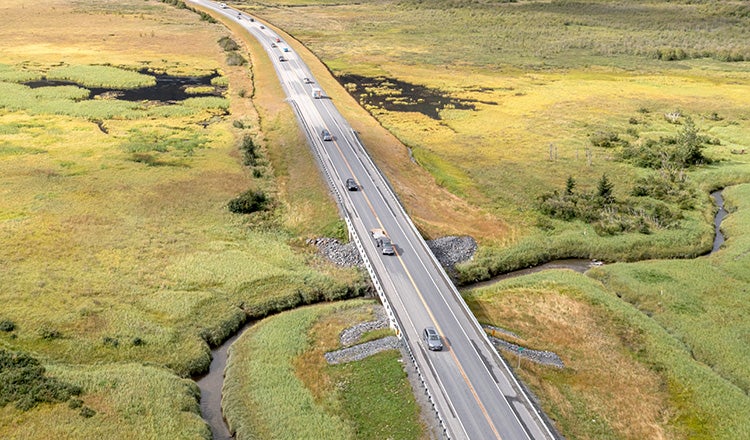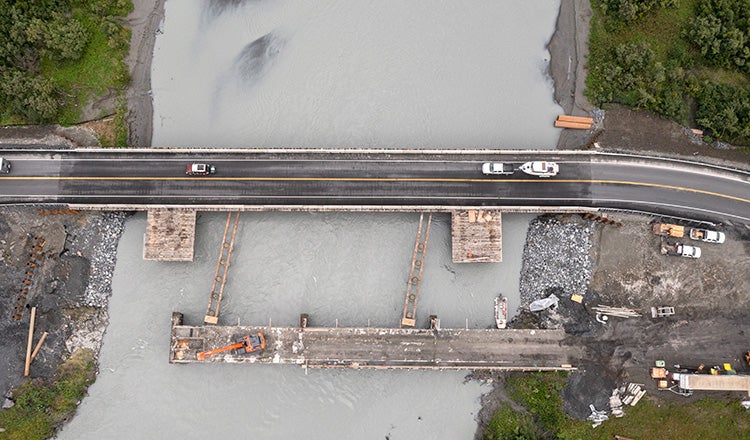Seward Highway Road and Bridge Rehabilitation

Seward Highway Road and Bridge Rehabilitation
Originally completed in 1951, the Seward Highway is the only road between Anchorage, Alaska, and the Kenai Peninsula. The highway passes through some of the most scenic areas in the United States and serves as a critical connector for communities. But the original design also lacked passing and turning lanes, contained deficient curves and led to frequent seasonal congestion.
The $138 million project to rehabilitate 15 miles of the highway, from mile posts 75 to 90, transformed the experience for travelers. HDR partnered with designers from the Alaska Department of Transportation and Public Facilities (DOT&PF) to straighten curves; replace or rehabilitate nine bridges; provide 5 miles of passing lanes in both directions and turn lanes at critical intersections; repave the entire stretch; enhance pedestrian facilities; improve drainage; and protect shorelines. With three new underpasses and an extended multimodal scenic trail, the project increases pedestrian safety and improves access to recreational spots. The project reached substantial completion in October 2023.
Major Environmental Challenges
The Seward Highway is built atop one of North America’s most challenging landscapes: with high seismic activity, highly liquifiable mudflats and a convergence of waterways, all home to essential fish habitat and the endangered beluga whale species. To construct the bridges and embankments, more than 235 structural steel piles were driven up to 150 feet deep to withstand the area’s highly liquifiable soils.

Multiple Bridge Reconstructions
Bridge design was led by DOT&PF's statewide bridge group. Eight of the nine bridges within the project corridor were near the end of their 50-year design lifespan, close to the implementation of weight restrictions and needing replacement. Their steel girder construction and steel piers left them prone to corrosion in the saline and brackish environment. Our team of hydraulics experts and roadway designers worked closely with the DOT&PF bridge designers to replace these eight structures with resilient bridges that will stand up to the region's harsh weather and seismic activity. The team also rehabilitated the ninth, constructed in 1985. The new bridges feature cast-in-place piles, caps and abutments, and precast deck bulb tee girders to expedite construction.
The Seward Highway experiences heavy traffic during peak summer tourism from late spring through early fall. At the same time, this is Alaska’s primary construction season. To limit traffic impacts, the team designed nearly all the bridges off alignment with a robust traffic control plan to minimize delays and develop construction phasing and detour plans. The project facilitated continuous traffic from campers to cruise ship bus charters.
Substantial Safety Improvements
Seward Highway was known for its high accident rate, with fatal crashes at more than twice the statewide rate. Perhaps most important, without sufficient parking in off-highway lots, cars often parked on the shoulder of the highway, resulting in roadside congestion and related safety issues, including pedestrians walking around and darting across the highway between vehicles.
Improvements are expected to significantly reduce the crash rate, with 5 miles of passing lanes in both directions, wider shoulders and turnoffs at popular attractions. Sharp compound curves on the road were also replaced with a single, larger radius horizontal curve that provides drivers a better line of sight.
To reduce highway shoulder parking, two 100-vehicle paved parking lots were added near mile posts 81 and 83, connected with an adjacent trail. This trail is then connected to a newly constructed 6-mile long multimodal pathway. This separated pathway safely allows access to the nearby Chugach National Forest, waterfront and riverways. Across the entire project, wider, 8-foot shoulders provide additional space for cyclists who pass beyond the multimodal pathway, particularly important when races and events draw riders to the corridor.

Roadway Innovations
A first in Alaska, the project implemented a new pavement marking design in the passing areas that guides slower traffic to the non-passing lanes. The alignment naturally encourages vehicles to stay in the right lane rather than keeping them in the left lane to then move over to let others pass. With much favorable reaction, this new pavement marking layout is being implemented on several other projects around the state.
The team also replaced and installed intelligent transportation system features, including road weather information systems, pavement sensors and automatic traffic recorders. A new mount for a howitzer artillery cannon simplifies avalanche mitigation setup in the winter.
Long Effort Continues to Pay Dividends
Over the nearly two decades of this project, the team consulted with nearly 45 federal, state and local agencies; local governments and departments; tribal organizations; and the public to obtain pertinent information, develop alternatives, identify issues and provide mitigation measures. The project required more than a dozen permits and authorizations.
The success of the mile post 75-90 project is helping the state transition to the next stretch of Seward Highway. Close to the northern terminus of this project, HDR is now performing preliminary design to help prepare the environmental document for the expansion of the highway from mile posts 98 to 118.










